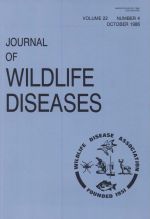Neonatal diarrhea was an important cause of morbidity and mortality in a hand-rearing facility for exotic ruminants at the San Diego Wild Animal Park. Studies undertaken to determine the causes of the problem revealed that oocysts of Cryptosporidium sp. were demonstrable in auramine O stained fecal smears from 52 of 183 (28.4%) animals examined. Cryptosporidia infection was identified in 21 of 40 species of exotic ruminants with diarrhea. In addition, Cryptosporidia were associated with gastroenteric disease in two primates and two reptiles. It was observed also that auramine O stained coccidial oocysts of the genus Eimeria, which were present in five of 183 (2.7%) of the specimens examined.
How to translate text using browser tools
1 October 1986
CRYPTOSPORIDIAL INFECTIONS IN CAPTIVE WILD ANIMALS
W. P. Heuschele,
J. Oosterhuis,
D. Janssen,
P. T. Robinson,
P. K. Ensley,
J. E. Meier,
T. Olson,
M. P. Anderson,
K. Benirschke





